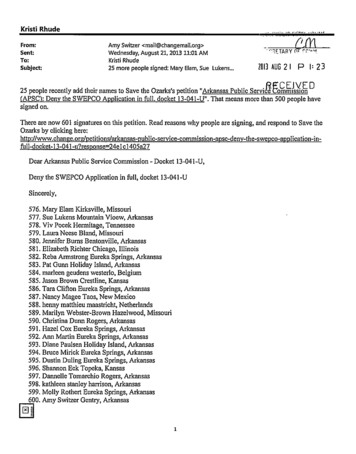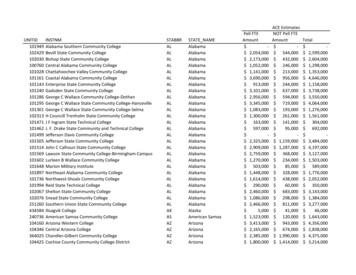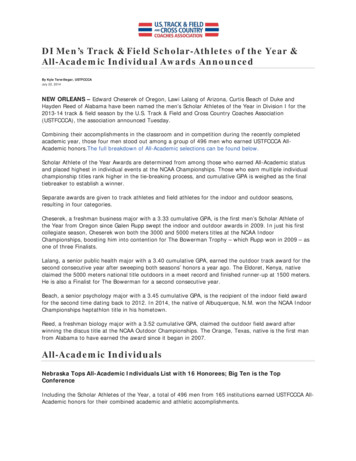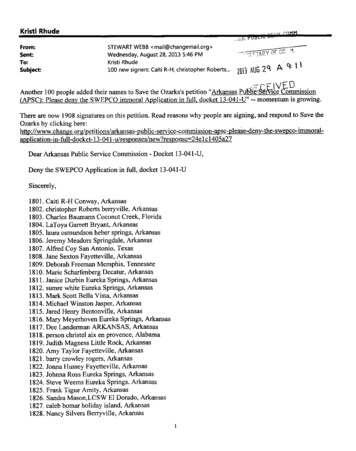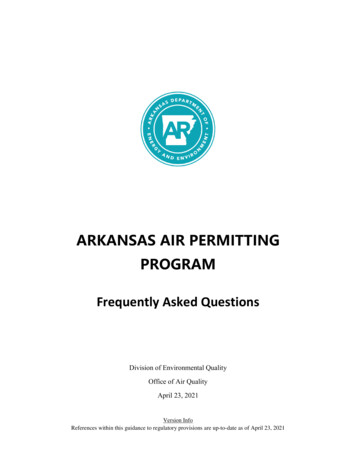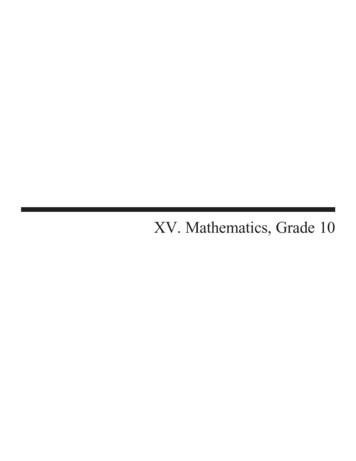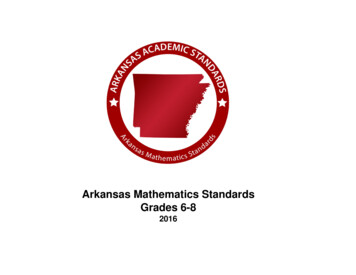
Transcription
Arkansas Mathematics StandardsGrades 6-82016
Introduction to the Grades 6-8 Arkansas Mathematics StandardsWhen charged with the task of revising the previous mathematics standards, a group of qualified individuals from across the state came togetherto craft standards that were specific for the schools and students of Arkansas. The result of this work, the Arkansas Mathematics Standards, iscontained in this document. These standards reflect what educators across our state know to be best for our students.These standards retain the same structure as the previous standards in terms of organization. The standards are organized by domains, clusters,and standards. Domains represent the big ideas that are to be studied at each grade level and sometimes across grade bands. These big ideassupport educators in determining the proper amount of focus and instructional time to be given to each of these topics.Clusters represent collections of standards that are grouped together to help educators understand the building blocks of rich and meaningfulinstructional units. These units help students make connections within clusters and avoid seeing mathematics as a discreet list of skills that theymust master. Standards represent the foundational building blocks of math instruction. The standards outlined in this document work together toensure that students are college and career ready and on track for success.There are additional similarities shared by these new standards and the previous standards. The main similarity is the structure of thenomenclature. The only change that was made to the naming system was intended to reflect that these standards belong to Arkansas. However,educators may still search for open education resources by using the last part of the label, which will link to the resources for the previousstandards. New standards can be found at the end of each cluster in which a new standard was deemed necessary.Another similarity to the previous standards is the use of the symbols ( ) and (*) to distinguish certain standards from others. The plus ( ) symbolis used to designate standards that are typically beyond the scope of an Algebra II course. However, some of the plus ( ) standards are nowincluded in courses that are not considered to be beyond Algebra II. Standards denoted with the asterisk (*) symbol represent the modelingcomponent of the standards. These standards should be presented in a modeling context where students are required to engage in the modelingprocess that is outlined in the Standards for Mathematical Practice.The revision committee opted to include some new elements in the Arkansas Mathematics Standards that represent an attempt at greater clarityand more consistent implementation across the state. Many of the revisions are a rewording of the original Common Core State Standards. Thepurpose of the rewording is often to help educators better understand the areas of emphasis and focus within the existing standard. Likewise,many of the standards are separated into a bulleted list of content. This does not mean that teachers should treat this content as a checklist ofitems that they must teach one at a time. The content was bulleted out so that teachers can better understand all that is included in some of thebroader standards.
Many of the examples that were included in the original standards were either changed for clarity or separated from the body of the actualstandard. The committee wanted educators to understand that the examples included in the body of the standards document in no way reflect all ofthe possible examples. Likewise, these examples do not mandate curriculum or problem types. Local districts are free to select the curriculum andinstructional methods they think best for their students.In some instances, notes of clarification were added. These notes were intended to clarify, for teachers, what the expectations are for the student.Likewise, these notes provide instructional guidance as well as limitations so that teachers can better understand the scope of the standard. Thiswill help the educators in determining what is developmentally appropriate for students when they are working with certain standards.Finally, the Arkansas Mathematics Standards will become a living document. The staff of the Arkansas Department of Education hopes that thisdocument portrays the hard work of the Arkansas educators who took part in the revision process and that it represents an improvement to theprevious set of standards. As these standards are implemented across schools in the state, the Arkansas Department of Education welcomesfurther suggestions related to notes of clarification, examples, professional development needs, and future revisions of the standards.Abbreviations:Ratios and Proportional Relationships – RPThe Number System – NSExpressions and Equations – EEGeometry – GStatistics and Probability – SPFunctions – F
Grade 6 – Arkansas Mathematics StandardsRatios andProportionalUnderstand ratio concepts and use ratio reasoning to solve problemsAR.Math.Content.6.RP.A.1Understand the concept of a ratio and use ratio language to describe a ratio relationship between twoquantitiesFor example, "The ratio of wings to beaks in the bird house at the zoo was 2:1, because for every 2wings there was 1 beak." "For every vote candidate A received, candidate C received nearly threevotes."AR.Math.Content.6.RP.A.2Understand the concept of a unit rate a/b associated with a ratio a:b with b 0, and use rate languagein the context of a ratio relationshipFor example, "This recipe has a ratio of 3 cups of flour to 4 cups of sugar, so there is 3/4 cup of flour foreach cup of sugar." "We paid 75 for 15 hamburgers, which is a rate of 5 per hamburger."Note: Expectations for unit rates in this grade are limited to non-complex fractions.AR.Math.Content.6.RP.A.3Use ratio and rate reasoning to solve real-world and mathematical problems (e.g., by reasoning abouttables of equivalent ratios, tape diagrams, double number line diagrams, or equations): Use and create tables to compare equivalent ratios relating quantities with whole-numbermeasurements, find missing values in the tables, and plot the pairs of values on the coordinateplaneSolve unit rate problems including those involving unit pricing and constant speedFor example: If it took 7 hours to mow 4 lawns, then at that rate, how many lawns could be mowedin 35 hours? At what rate were lawns being mowed?Find a percent of a quantity as a rate per 100 (e.g., 30% of a quantity means 30/100times the quantity)Solve problems involving finding the whole, given a part and the percentUse ratio reasoning to convert measurement units; manipulate and transform unitsappropriately when multiplying or dividing quantitiesExample: How many centimeters are in 7 feet, given that 1 inch 2.54 cm?Note: Conversion factors will be given. Conversions can occur both between and across the metric andEnglish system. Estimates are not expected.3
Grade 6 – Arkansas Mathematics StandardsThe Number SystemAR.Math.Content.6.NS.A.1Apply and extend previous understandings of multiplication and division to divide fractions byfractions Interpret and compute quotients of fractionsSolve word problems involving division of fractions by fractions (e.g., by using variousstrategies, including but not limited to, visual fraction models and equations to represent theproblem)For example: Create a story context for (2/3) (3/4) and use a visual fraction model to show the quotient;use the relationship between multiplication and division to explain that (2/3) (3/4) 8/9 because 3/4 of8/9 is 2/3. How many 3/4-cup servings are in 2/3 of a cup of yogurt?Note: In general, (a/b) (c/d) ad/bc.The Number SystemCompute fluently with multi-digit numbers and find common factors and multiplesAR.Math.Content.6.NS.B.2Use computational fluency to divide multi-digit numbers using a standard algorithmNote: A standard algorithm can be viewed as, but should not be limited to, the traditional recordingsystem. A standard algorithm denotes any valid base-ten strategy.AR.Math.Content.6.NS.B.3Use computational fluency to add, subtract, multiply, and divide multi-digit decimals and fractionsusing a standard algorithm for each operationNote: A standard algorithm can be viewed as, but should not be limited to, the traditional recordingsystem. A standard algorithm denotes any valid base-ten strategy.AR.Math.Content.6.NS.B.4 Find the greatest common factor of two whole numbers less than or equal to 100 usingprime factorization as well as other methodsFind the least common multiple of two whole numbers less than or equal to 12 usingprime factorization as well as other methodsUse the distributive property to express a sum of two whole numbers 1-100 with a common factoras a multiple of a sum of two whole numbers with no common factorFor example, express 36 8 as 4 (9 2).4
Grade 6 – Arkansas Mathematics StandardsThe Number SystemApply and extend previous understandings of numbers to the system of rational numbersAR.Math.Content.6.NS.C.5Understand that positive and negative numbers are used together to describe quantities havingopposite directions or values, explaining the meaning of 0 (e.g., temperature above/below zero,elevation above/below sea level, credits/debits, positive/negative electric charge)AR.Math.Content.6.NS.C.6Understand a rational number as a point on the number lineExtend number line diagrams and coordinate axes familiar from previous grades to represent pointson the line and in the plane with negative number coordinates: Recognize opposite signs of numbers as indicating locations on opposite sides of 0 on the numberline Recognize that the opposite of the opposite of a number is the number itself (e.g., -(-3) 3, andthat 0 is its own opposite) Understand signs of numbers in ordered pairs as indicating locations in quadrants of thecoordinate plane Recognize that when two ordered pairs differ only by signs, the locations of the points arerelated by reflections across one or both axes Find and position integers and other rational numbers on a horizontal or vertical number line diagram Find and position pairs of integers and other rational numbers on a coordinate planeAR.Math.Content.6.NS.C.7Understand ordering and absolute value of rational numbers: Interpret statements of inequality as statements about the relative position of two numbers on anumber line diagramFor example, interpret -3 -7 as a statement that -3 is located to the right of -7 on a number lineoriented from left to right. Write, interpret, and explain statements of order for rational numbers in real-world contextsFor example, write -3o C -7o C to express the fact that -3o C is warmer than -7o C. Understand the absolute value of a rational number as its distance from 0 on the number line Interpret absolute value as magnitude for a positive or negative quantity in a real-world situationFor example, for an account balance of -30 dollars, write -30 30 to describe the size of thedebt in dollars. Distinguish comparisons of absolute value from statements about orderFor example, recognize that an account balance less than -30 dollars represents a debt greaterthan 30 dollars.5
AR.Math.Content.6.NS.C.8 Grade 6 – Arkansas Mathematics StandardsSolve real-world and mathematical problems by graphing points in all four quadrants of thecoordinate planeUse coordinates and absolute value to find distances between points with the same firstcoordinate or the same second coordinate6
Grade 6 – Arkansas Mathematics StandardsExpressions and EquationsApply and extend previous understandings of arithmetic to algebraic expressionsAR.Math.Content.6.EE.A.1Write and evaluate numerical expressions involving whole-number exponentsAR.Math.Content.6.EE.A.2Write, read, and evaluate expressions in which letters (variables) stand for numbers: Write expressions that record operations with numbers and with letters standing for numbersFor example, express the calculation ‘subtract y from 5’ or ‘y less than 5’ as 5 - y. Identify parts of an expression using mathematical terms (sum, term, product, factor, quotient,coefficient); view one or more parts of an expression as a single entityFor example, describe the expression 2 (8 7) as a product of two factors; view (8 7) asboth a single entity and a sum of two terms. Evaluate expressions at specific values of their variables Include expressions that arise from formulas used in real-world problems Perform arithmetic operations, including those involving whole-number exponents, in theconventional order when there are no parentheses to specify a particular order (Order ofOperations)For example, use the formulas involved in measurement such as V s3 and A 6s2 to find thevolume and surface area of a cube with sides of length s 1/2.AR.Math.Content.6.EE.A.3Apply the properties of operations to generate equivalent expressionsFor example: Apply the distributive property to the expression 3(2 x) to produce the equivalent expression6 3x; apply the distributive property to the expression 24x 18y to produce the equivalent expression6(4x 3y); apply properties of operations to y y y to produce the equivalent expression 3y.Note: Includes but not limited to the distributive property.AR.Math.Content.6.EE.A.4Identify when two expressions are equivalent (i.e., when the two expressions name the samenumber regardless of which value is substituted into them)For example: The expressions y y y and 3y are equivalent because they name the same numberregardless of which number y stands for.7
Grade 6 – Arkansas Mathematics StandardsExpressions and EquationsReason about and solve one-variable equations and inequalitiesAR.Math.Content.6.EE.B.5Understand solving an equation or inequality as a process of answering a question: Using substitution, which values from a specified set, if any, make the equation or inequality true?AR.Math.Content.6.EE.B.6 Use variables to represent numbers and write expressions when solving a real-world ormathematical problem Understand that a variable can represent an unknown number or any number in a specified setAR.Math.Content.6.EE.B.7Solve real-world and mathematical problems by writing and solving equations of the form x p q and px qfor cases in which p, q and x are all nonnegative rational numbersAR.Math.Content.6.EE.B.8For real world or mathematical problems: Write an inequality of the form x c, x c, x c, or x c to represent a constraint or condition Recognize that inequalities of the form x c or x c have infinitely many solutions Represent solutions of such inequalities on number line diagramsExpressions and EquationsRepresent and analyze quantitative relationships between dependent and independent variablesAR.Math.Content.6.EE.C.9Use variables to represent two quantities in a real-world problem that change in relationship to one another: Write an equation to express one quantity, thought of as the dependent variable, in terms of theother quantity, thought of as the independent variable Analyze the relationship between the dependent and independent variables using graphs andtables, and relate these to the equationFor example: In a problem involving motion at constant speed, list and graph ordered pairs of distancesand times, and write the equation d 65t to represent the relationship between distance and time.Note: The independent variable is the variable that can be changed; the dependent variable is the variablethat is affected by the change in the independent variable.8
Grade 6 – Arkansas Mathematics StandardsGeometrySolve real-world and mathematical problems involving area, surface area, and volumeAR.Math.Content.6.G.A.1 Find the area of right triangles, other triangles, special quadrilaterals, and polygons bycomposing into rectangles or decomposing into triangles and other shapes Apply these techniques in the context of solving real-world and mathematical problemsNote: Trapezoids will be defined to be a quadrilateral with at least one pair of opposite sides parallel,therefore all parallelograms are trapezoids.AR.Math.Content.6.G.A.2 Find the volume of a right rectangular prism including whole number and fractional edge lengthsby packing it with unit cubes of the appropriate unit fraction edge lengths, and show that thevolume is the same as would be found by multiplying the edge lengths of the prismApply the formulas V l w h and V B h to find volumes of right rectangular prisms includingfractional edge lengths in the context of solving real-world and mathematical problemsAR.Math.Content.6.G.A.3Apply the following techniques in the context of solving real-world and mathematical problems: Draw polygons in the coordinate plane given coordinates for the vertices Use coordinates to find the length of a side joining points with the same first coordinate or thesame second coordinateAR.Math.Content.6.G.A.4Apply the following techniques in the context of solving real-world and mathematical problems: Represent three-dimensional figures using nets made up of rectangles and triangles Use the nets to find the surface area of these figures9
Grade 6 – Arkansas Mathematics StandardsStatistics and ProbabilityDevelop understanding of statistical variabilityAR.Math.Content.6.SP.A.1Recognize a statistical question as one that anticipates variability in the data related to the questionand accounts for it in the answersFor example, ‘How old am I?’ is not a statistical question, but ‘How old are the students in my school?’is a statistical question because one anticipates variability in students' ages.Note: Statistics is also the name for the science of collecting, analyzing and interpreting data. Dataare the numbers produced in response to a statistical question and are frequently collected from surveysor other sources (i.e. .6.SP.A.3Determine center, spread, and overall shape from a set of dataRecognize that a measure of center for a numerical data set summarizes all of its values with a singlenumber (mean, median, mode), while a measure of variation (interquartile range, mean absolutedeviation) describes how its values vary with a single numberExample: If the mean height of the students in the class is 48” are there any students in the classtaller than 48”?Statistics and ProbabilitySummarize and describe nt.6.SP.B.5Display numerical data in plots on a number line, including dot plots, histograms, and box plotsSummarize numerical data sets in relation to their context, such as by: Reporting the number of observations Describing the nature of the attribute under investigation, including how it was measured and itsunits of measurement Calculate quantitative measures of center (including but not limited to median and mean)and variability (including but not limited to interquartile range and mean absolute deviation) Use the calculations to describe any overall pattern and any striking deviations (outliers)from the overall pattern with reference to the context in which the data were gatheredNote: Instructional focus should be on summarizing and describing data distributions. Relating the choice of measures of center and variability to the shape of the data distribution andthe context in which the data were gathered. For example, demonstrate in the case where there areoutliers in the data median would be a better measure of center than the mean.10
Grade 7 – Arkansas Mathematics StandardsRatios andProportionalAnalyze proportional relationships and use them to solve real-world and mathematical problemsAR.Math.Content.7.RP.A.1Compute unit rates associated with ratios of fractions, including ratios of lengths, areas, and otherquantities measured in like or different unitsAR.Math.Content.7.RP.A.2For example: If a person walks 1/2 mile in each 1/4 hour, compute the unit rate as the complex fraction1/2/1/4 miles per hour, equivalently 2 miles per hour.Recognize and represent proportional relationships between quantities: Decide whether two quantities are in a proportional relationship (e.g., by testing for equivalentratios in a table or graphing on a coordinate plane and observing whether the graph is a straightline through the origin) Identify unit rate (also known as the constant of proportionality) in tables, graphs,equations, diagrams, and verbal descriptions of proportional relationships Represent proportional relationships by equations (e.g., if total cost t is proportional to thenumber n of items purchased at a constant price p, the relationship between the total cost andthe number of items can be expressed as t pn) Explain what a point (x, y) on the graph of a proportional relationship means in terms of thesituation, with special attention to the points (0, 0) and (1, r) where r is the unit rateNote: Unit rate connects to slope concept in 8th grade.AR.Math.Content.7.RP.A.3Use proportional relationships to solve multi-step ratio and percent problemsNote: Examples include but are not limited to simple interest, tax, markups and markdowns, gratuitiesand commissions, fees, percent increase and decrease.11
Grade 7 – Arkansas Mathematics StandardsThe Number SystemApply and extend previous understandings of operations with fractionsAR.Math.Content.7.NS.A.1Apply and extend previous understandings of addition and subtraction to add and subtract rationalnumbersRepresent addition and subtraction on a horizontal or vertical number line diagram: Describe situations in which opposite quantities combine to make 0 and show that a number andits opposite have a sum of 0 (additive inverses) (e.g., A hydrogen atom has 0 charge because itstwo constituents are oppositely charged.) Understand p q as a number where p is the starting point and q represents a distance from p inthe positive or negative direction depending on whether q is positive or negative Interpret sums of rational numbers by describing real-world contexts (e.g., 3 2 means beginning at3, move 2 units to the right and end at the sum of 5; 3 (-2) means beginning at 3, move 2 units tothe left and end at the sum of 1; 70 (-30) 40 could mean after earning 70, 30 was spent on anew video game, leaving a balance of 40) Understand subtraction of rational numbers as adding the additive inverse, p - q p (-q) Show that the distance between two rational numbers on the number line is the absolute value oftheir difference and apply this principle in real-world contexts (e.g., the distance between -5 and 6is 11. -5 and 6 are 11 units apart on the number line)AR.Math.Content.7.NS.A.2Apply and extend previous understandings of multiplication and division and of fractions to multiply anddivide rational numbers: Understand that multiplication is extended from fractions to all rational numbers by requiring thatoperations continue to satisfy the properties of operations, particularly the distributive property, andthe rules for multiplying signed numbers Interpret products of rational numbers by describing real-world contexts Understand that integers can be divided, provided that the divisor is not zero, and every quotient ofintegers (with non-zero divisor) is a rational number (e.g., if p and q are integers, then -(p/q) (-p)/q p/(-q)) Interpret quotients of rational numbers by describing real-world contexts Fluently multiply and divide rational numbers by applying properties of operations as strategies Convert a fraction to a decimal using long division Know that the decimal form of a fraction terminates in 0s or eventually repeatsAR.Math.Content.7.NS.A.3Solve real-world and mathematical problems involving the four operations with rational numbers,including but not limited to complex fractions12
Grade 7 – Arkansas Mathematics StandardsExpressions and EquationsUse properties of operations to generate equivalent expressionsAR.Math.Content.7.EE.A.1Apply properties of operations as strategies to add, subtract, expand, and factor linear expressionswith rational coefficientsUnderstand how the quantities in a problem are related by rewriting an expression in different formsAR.Math.Content.7.EE.A.2For example: a 0.05a 1.05a means that ‘increase by 5%’ is the same as ‘multiply by 1.05’ or theperimeter of a square with side length s can be written as s s s s or 4s.Expressions and EquationsSolve real-life and mathematical problems using numerical and algebraic expressions and equationsAR.Math.Content.7.EE.B.3Solve multi-step, real-life, and mathematical problems posed with positive and negative rational numbersin any form using tools strategically: Apply properties of operations to calculate with numbers in any form (e.g., -(1/4)(n-4)) Convert between forms as appropriate (e.g., if a woman making 25 an hour gets a 10% raise,she will make an additional 1/10 of her salary an hour, or 2.50, for a new salary of 27.50) Assess the reasonableness of answers using mental computation and estimation strategies (e.g.,if you want to place a towel bar 9 3/4 inches long in the center of a door that is 27 1/2 incheswide, you will need to place the bar about 9 inches from each edge; this estimate can be used asa check on the exact computation)AR.Math.Content.7.EE.B.4 Use variables to represent quantities in a real-world or mathematical problemConstruct simple equations and inequalities to solve problems by reasoning about the quantitiesSolve word problems leading to equations of these forms px q r and p(x q) r, where p, q, and rare specific rational numbers. Solve equations of these forms fluentlyWrite an algebraic solution identifying the sequence of the operations used to mirror the arithmeticsolution (e.g., The perimeter of a rectangle is 54 cm. Its length is 6 cm. What is its width? Subtract2*6 from 54 and divide by 2; (2*6) 2w 54)Solve word problems leading to inequalities of the form px q r or px q r, where p, q, and rare specific rational numbersGraph the solution set of the inequality and interpret it in the context of the problem (e.g., As asalesperson, you are paid 50 per week plus 3 per sale. This week you want your pay to be atleast 100. Write an inequality for the number of sales you need to make, and describe thesolutions.)13
Grade 7 – Arkansas Mathematics StandardsGeometryDraw construct, and describe geometrical figures and describe the relationships between themAR.Math.Content.7.G.A.1Solve problems involving scale drawings of geometric figures, including computing actual lengths andareas from a scale drawing and reproducing a scale drawing at a different scaleNote: This concept ties into ratio and 7.G.A.3Draw (freehand, with ruler and protractor, and with technology) geometric shapes with given conditions: Given three measures of angles or sides of a triangle, notice when the conditions determine aunique triangle, more than one triangle, or no triangle Differentiate between regular and irregular polygonsDescribe the two-dimensional figures that result from slicing three-dimensional figures, as in planesections of right rectangular prisms and right rectangular pyramidsGeometrySolve real-life and mathematical problems involving angle measure, area, surface area and volumeAR.Math.Content.7.G.B.4 Know the formulas for the area and circumference of a circle and use them to solve problems. Give an informal derivation of the relationship between the circumference and area of a circleUse facts about supplementary, complementary, vertical, and adjacent angles in a multi-step problem towrite and solve simple equations for an unknown angle in a figureSolve real-world and mathematical problems involving area of two-dimensional objects and volumeand surface area of three-dimensional objects composed of triangles, quadrilaterals, polygons, cubes,and right .614
Grade 7 – Arkansas Mathematics StandardsStatistics and ProbabilityUse random sampling to draw inferences about a populationAR.Math.Content.7.SP.A.1Understand that: Statistics can be used to gain information about a population by examining a sample of the population Generalizations about a population from a sample are valid only if the sample is representative ofthat population Random sampling tends to produce representative samples and support valid inferencesAR.Math.Content.7.SP.A.2 Use data from a random sample to draw inferences about a population with a specific characteristic Generate multiple samples (or simulated samples) of the same size to gauge the variation inestimates or predictionsFor example: Estimate the mean word length in a book by randomly sampling words from the book, orpredict the winner of a school election based on randomly sampled survey data. Gauge how far off theestimate or prediction might be.Statistics and ProbabilityDraw informal comparative inferences about two populationsAR.Math.Content.7.SP.B.3Draw conclusions about the degree of visual overlap of two numerical data distributions with similarvariability such as interquartile range or mean absolute de viation, expressing the difference between thecenters as a multiple of a measure of variability such as mean, median, or modeFor example: The mean height of players on the basketball team is 10 cm greater than the mean heightof players on the soccer team, about twice the variability on either team; on a dot plot, the separationbetween the two distributions of heights is noticeable.AR.Math.Content.7.SP.B.4Draw informal comparative inferences about two populations using measures of center andmeasures of variability for numerical data from random samplesFor example: Decide whether the words in a chapter of a seventh-grade science book are generallylonger than the words in a chapter of a fourth-grade scien
Write, interpret, and explain statements of order for rational numbers in real-world contexts . For example, write o -3. o . C -7. o . C to express the fact that -3. o . C is warmer than -7. C. Understand the . absolute value. of a rational number as its distance from 0 on the number line Interpret . absolute value
